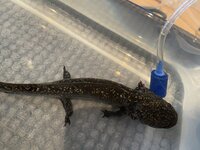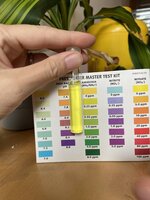HayleyStar7
New member
Hi, need some help with our sick axolotl. We are newbies and didn’t set the tank up correctly due to not researching enough - please don’t judge, am committed to proper care moving forward!
We’ve had a wild type since December last year and noticed on Monday night that he was floating and was still floating Tuesday morning. I took him out and have been tubbing him ever since with an airstone and water changes 1-2 x daily. I think it was ammonia and nitrates could have been a bit too high? Also possibly fungus as I measured the water temp and it was 22/72. He was looking better on Wednesday but worse on Thursday so I gave him a salt bath due to noticing a white mucous film on his skin and around his gills. He was much better by Friday and has stopped floating now and is moving around more. He’s just hanging out in the corner near the bubbler. Water temp is now sitting around 20/68. Have him a second salt bath yesterday and he’s still doing okay although the kink has returned to the end of his tail today. He hasn’t eaten at all since taking him out of his tank and I’m worried about his weight as he is very skinny. His gills are very small and his feet don’t look right, but TBH he looked like the is when we got him from the pet store and not knowing any different I thought it was just because he was young.
Q - what can I do to get him to eat and should I fridge him if he’s stopped floating but still won’t eat?
I tested the water for the first time on Tuesday with API for ammonia and test stick for other parameters. Looked like ammonia was 0.25ppm, nitrites 0, nitrates 40ppm, pH 6.8.
Have been cleaning and doing a few partial water changes and added bacteria through the week. I tested again yesterday with API master kit - pH 6.8, ammonia 0, nitrite 0, nitrate 0. Was worried about having all zero readings might indicate there is no cycle, so added some food to the tank to test if that made a difference. Also increased pH.
Tested today and parameters are pH 8?, ammonia 0.25?, nitrite 0, nitrate 5. Does this mean we have an active cycle in the tank? What else do we need to do to get the water quality right before returning our axie to the tank?
Q - should I keep working with this water or empty completely and clean and start again? If we keep this water should I add some ammonia to properly test if the cycle is working? Or start a complete new cycle? Or does it look okay if we can get the pH right and zero ammonia and nitrite with some nitrates?
Have added some photos of our axie and his new tank set up as well as todays water test results. The tank is 60L and we had been keeping it half full at around 30L. I’ve increased that a bit now. We only had the sponge filter before so have bought a new filter with bio filter - Fluval U2 which is running in the tank. I think the current might be too strong though.
Any advice from more experienced axie owners would be much appreciated! Thanks.
We’ve had a wild type since December last year and noticed on Monday night that he was floating and was still floating Tuesday morning. I took him out and have been tubbing him ever since with an airstone and water changes 1-2 x daily. I think it was ammonia and nitrates could have been a bit too high? Also possibly fungus as I measured the water temp and it was 22/72. He was looking better on Wednesday but worse on Thursday so I gave him a salt bath due to noticing a white mucous film on his skin and around his gills. He was much better by Friday and has stopped floating now and is moving around more. He’s just hanging out in the corner near the bubbler. Water temp is now sitting around 20/68. Have him a second salt bath yesterday and he’s still doing okay although the kink has returned to the end of his tail today. He hasn’t eaten at all since taking him out of his tank and I’m worried about his weight as he is very skinny. His gills are very small and his feet don’t look right, but TBH he looked like the is when we got him from the pet store and not knowing any different I thought it was just because he was young.
Q - what can I do to get him to eat and should I fridge him if he’s stopped floating but still won’t eat?
I tested the water for the first time on Tuesday with API for ammonia and test stick for other parameters. Looked like ammonia was 0.25ppm, nitrites 0, nitrates 40ppm, pH 6.8.
Have been cleaning and doing a few partial water changes and added bacteria through the week. I tested again yesterday with API master kit - pH 6.8, ammonia 0, nitrite 0, nitrate 0. Was worried about having all zero readings might indicate there is no cycle, so added some food to the tank to test if that made a difference. Also increased pH.
Tested today and parameters are pH 8?, ammonia 0.25?, nitrite 0, nitrate 5. Does this mean we have an active cycle in the tank? What else do we need to do to get the water quality right before returning our axie to the tank?
Q - should I keep working with this water or empty completely and clean and start again? If we keep this water should I add some ammonia to properly test if the cycle is working? Or start a complete new cycle? Or does it look okay if we can get the pH right and zero ammonia and nitrite with some nitrates?
Have added some photos of our axie and his new tank set up as well as todays water test results. The tank is 60L and we had been keeping it half full at around 30L. I’ve increased that a bit now. We only had the sponge filter before so have bought a new filter with bio filter - Fluval U2 which is running in the tank. I think the current might be too strong though.
Any advice from more experienced axie owners would be much appreciated! Thanks.
Attachments
-
 60C6CFE1-6B04-4C02-AC65-A26ECEE6F0A3.jpeg1.6 MB · Views: 495
60C6CFE1-6B04-4C02-AC65-A26ECEE6F0A3.jpeg1.6 MB · Views: 495 -
 1323CE3A-510E-42A5-9570-C914C1127ADA.jpeg3 MB · Views: 103
1323CE3A-510E-42A5-9570-C914C1127ADA.jpeg3 MB · Views: 103 -
 098BDAFA-4129-49B2-B9F9-FB91E4509481.jpeg1.5 MB · Views: 117
098BDAFA-4129-49B2-B9F9-FB91E4509481.jpeg1.5 MB · Views: 117 -
 BB328148-AAF4-4E44-B6B1-E6E8F824EDD6.jpeg3.2 MB · Views: 102
BB328148-AAF4-4E44-B6B1-E6E8F824EDD6.jpeg3.2 MB · Views: 102 -
 74028B59-69CC-4E6B-ACA5-18777D8C3291.jpeg1.4 MB · Views: 104
74028B59-69CC-4E6B-ACA5-18777D8C3291.jpeg1.4 MB · Views: 104 -
 D34B86F5-13EC-4D66-9E00-B38E75188034.jpeg1.4 MB · Views: 103
D34B86F5-13EC-4D66-9E00-B38E75188034.jpeg1.4 MB · Views: 103 -
 F2727EF8-3209-477A-B92A-03DAE8F5786F.jpeg1.2 MB · Views: 107
F2727EF8-3209-477A-B92A-03DAE8F5786F.jpeg1.2 MB · Views: 107
